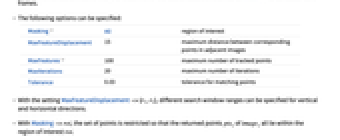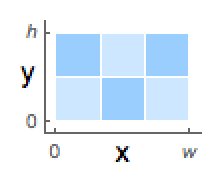ImageFeatureTrack[{image1,image2,…,imagen}]
tracks features from image1 through imagen.
ImageFeatureTrack[video]
tracks features in frames of video.
ImageFeatureTrack[input,pts]
tracks features starting from the initial set of points pts in the first image or video frame.


ImageFeatureTrack
ImageFeatureTrack[{image1,image2,…,imagen}]
tracks features from image1 through imagen.
ImageFeatureTrack[video]
tracks features in frames of video.
ImageFeatureTrack[input,pts]
tracks features starting from the initial set of points pts in the first image or video frame.
Details and Options


- ImageFeatureTrack, also known as feature tracking, tracks feature points over time.
- ImageFeatureTrack works with a Video object, an AnimatedImage object or a sequence of images.
- ImageFeatureTrack[input] automatically determines a set of feature points in the first image or first video frame to track.
- When tracking points in an image sequence or an AnimatedImage, a list {pts1,pts2,…,ptsn} is returned, where ptsi is the position of the features in imagei.
- Coordinates {x,y} are assumed to be in the standard image coordinate system.
- If a point is not found in some image or video frame, the coordinates are returned as Missing[] for all subsequent frames.
- The following options can be specified:
-
Masking All region of interest MaxFeatureDisplacement 15 maximum distance between corresponding points in adjacent images MaxFeatures 100 maximum number of tracked points MaxIterations 20 maximum number of iterations Tolerance 0.03 tolerance for matching points - With the setting MaxFeatureDisplacement->{r1,r2}, different search window ranges can be specified for vertical and horizontal directions.
- With Masking->roi, the set of points is restricted so that the returned points pts1 of image1 all lie within the region of interest roi.
- The tracking between subsequent images is computed by an iterative algorithm. With MaxIterations->n and Tolerance->tol, the algorithm terminates when the iterative displacement is less than tol or the number of iterations exceeds n.

Examples
open all close allScope (4)
Options (2)
Applications (3)
Show the optical flow of points in two images:
Track the image corners between images:
Track a point on the face of a woman dancing on the stage, to analyze the dance:
The number of taps the performer makes can be computed from the ![]() coordinate of the tracked point:
coordinate of the tracked point:
Find the number of jumps/taps frequency from the number of peaks:
Interactive Examples (1)
History
Introduced in 2012 (9.0) | Updated in 2014 (10.0) ▪ 2015 (10.1) ▪ 2022 (13.1) ▪ 2025 (14.3)
Text
Wolfram Research (2012), ImageFeatureTrack, Wolfram Language function, https://reference.wolfram.com/language/ref/ImageFeatureTrack.html (updated 2025).
CMS
Wolfram Language. 2012. "ImageFeatureTrack." Wolfram Language & System Documentation Center. Wolfram Research. Last Modified 2025. https://reference.wolfram.com/language/ref/ImageFeatureTrack.html.
APA
Wolfram Language. (2012). ImageFeatureTrack. Wolfram Language & System Documentation Center. Retrieved from https://reference.wolfram.com/language/ref/ImageFeatureTrack.html
BibTeX
@misc{reference.wolfram_2025_imagefeaturetrack, author="Wolfram Research", title="{ImageFeatureTrack}", year="2025", howpublished="\url{https://reference.wolfram.com/language/ref/ImageFeatureTrack.html}", note=[Accessed: 26-November-2025]}
BibLaTeX
@online{reference.wolfram_2025_imagefeaturetrack, organization={Wolfram Research}, title={ImageFeatureTrack}, year={2025}, url={https://reference.wolfram.com/language/ref/ImageFeatureTrack.html}, note=[Accessed: 26-November-2025]}